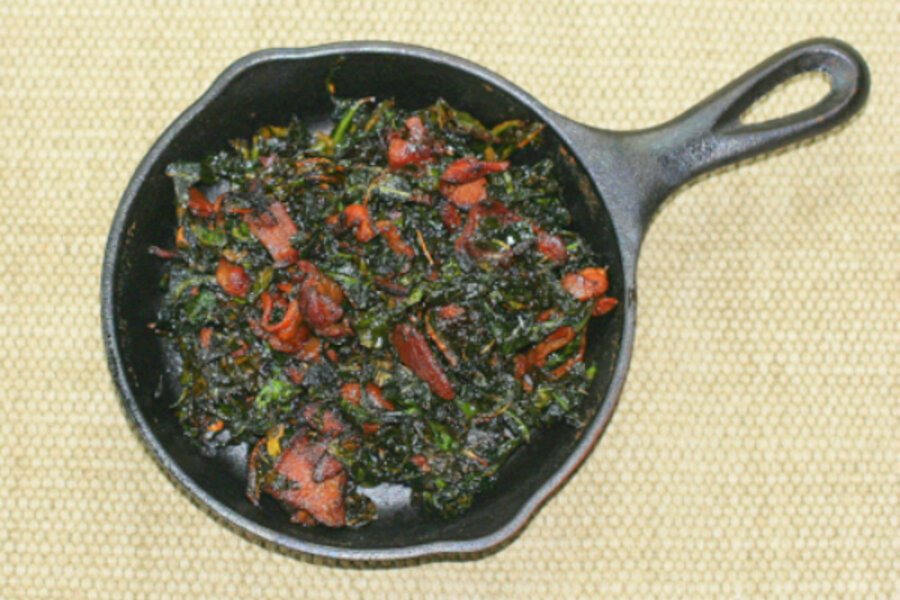Collard greens to pair with black-eyed peas
Loading...
I adhere very solidly to tradition of eating black eyed peas and greens on New Year’s day for luck and prosperity. I have a wonderful New Year’s Eve tradition, so on New Year’s Day, I usually sleep in, then curl up on the couch with a book while a pot of peas and some collards stew away on the stove – minimal prep and minimal work. But this cast-iron skillet, bacon-fried version of collards is a quicker method, if you don’t get around to cooking until its almost time for dinner. If you really sleep in after a night out. Or they make an excellent accompaniment to a bowl of slow-cooked peas.
I think these are collards for people who don’t like collards. The bacon of courses helps, as does the fact that these are thin strands of greens, rather than a big leaf. And the sugar slightly caramelizes the greens and the bacon, adding an interesting touch of sweet. A big bunch of collards wilts down to a small amount – this makes about 2 cups of cooked greens, so its just enough for a small side. These are really interesting used as a garnish on a big bowl of black-eyed peas or hopping john, just place a tangle of the collards on top. They could even add an extra dimension to soft, slow cooked collards. You can certainly double the recipe or make multiple batches.
Cast Iron Collards
Serves 4 as an accompaniment
1 large bunch collard greens
1 tablespoon vegetable oil
6 strips bacon
1 garlic clove
a pinch of red pepper flakes
1 tablespoon sugar
1/2 teaspoon baking soda
1/2 teaspoon salt
1. Cut the leaves of the collards away from the hard center stems. Stack the leaves up in bunches of about 6, then roll each bunch into a cigar. Cut the collards into thin ribbons. Place the collard ribbons in a colander, shuffling them around to make sure they are well separated. Rinse the collards thoroughly and shake as much water of as possible. Lay the collard ribbons out on a tea towel, then roll them up in the towel to blot off as much water as you can. A little damp is fine, soaking wet will be a problem when you add them to the bacon grease.
2. Put the vegetable oil and bacon strips into a large, deep cast iron skillet and cook over medium heat until the bacon is very crispy and the fat has rendered out. Do not be tempted to raise the heat or the grease will get to hot and scorch the greens. When the bacon is crispy, remove it to paper towels to drain. Drop the garlic clove and the red pepper flakes into the pan and cook for just until the garlic starts to brown and is fragrant, about 20 seconds. Remove the garlic clove.
3. Carefully add the collards to the pan, standing back because the moisture on the greens will spit. Stir the collards to coat in the bacon fat and cook, stirring frequently for about 5 minutes until the greens are wilted. Add the sugar, baking soda and salt and stir well. Chop the bacon into rough pieces, add them to the greens and stir. Lower the heat, cover the pan and cook the greens for about 8 minutes, stirring frequently, until they are tender. Watch carefully so they do not burn. The greens will be dark and soft, with a few crispy edges here and there.
Serve immediately, sprinkled with a little pepper vinegar if you’d like.





